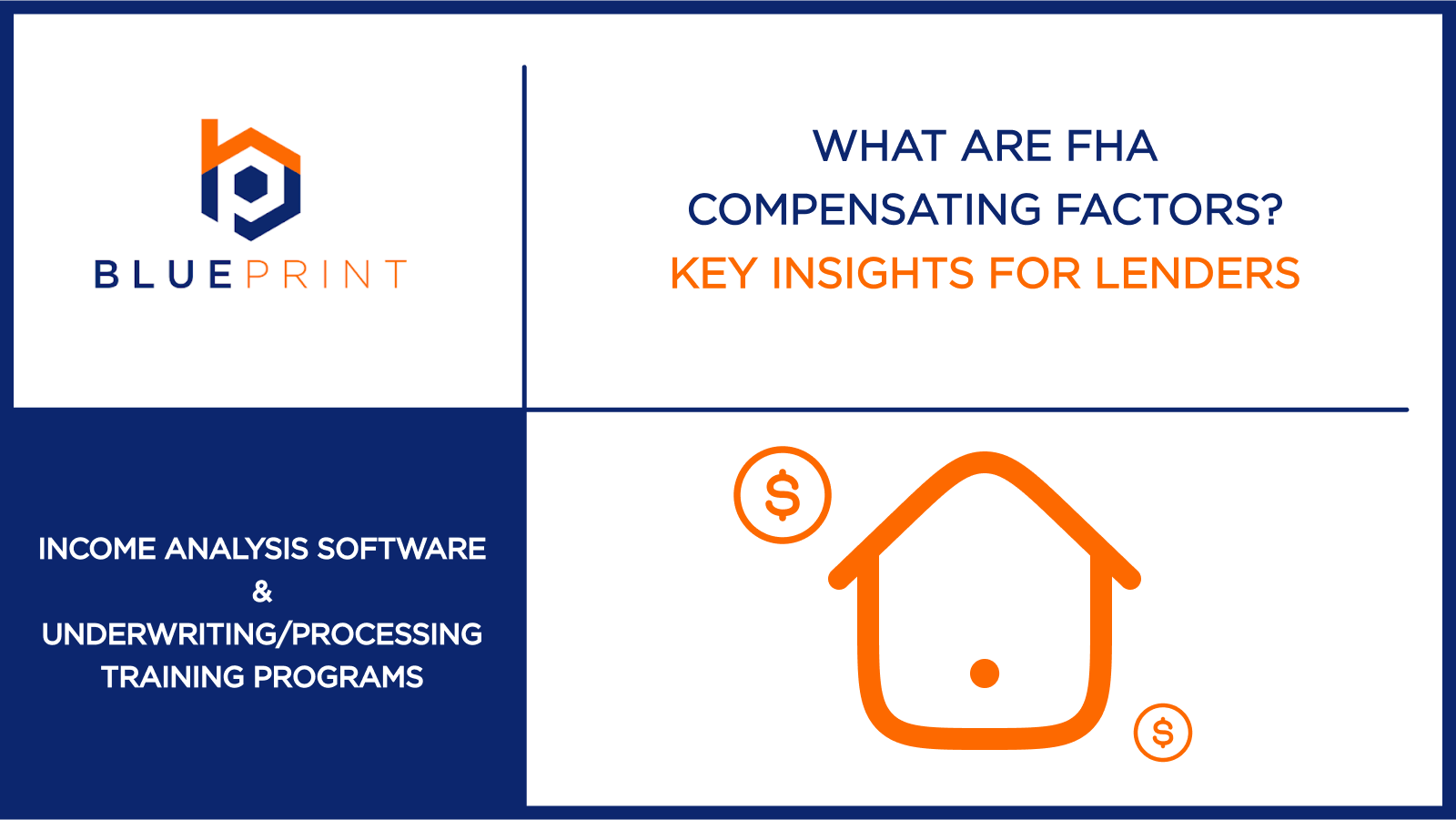FHA loans provide a way to homeownership for Americans who don’t qualify for conventional financing. While these government-backed Federal Housing Administration loans offer flexible qualification standards, they maintain core requirements to manage risk.
When borrowers fall short of standard metrics, compensating factors become essential tools in the process. This article examines how FHA lenders can assess financially strong borrowers using alternative evaluation methods.
Main takeaways from this article:
- FHA compensating factors allow underwriters to approve borrowers who don’t meet standard FHA requirements during the loan application process.
- Commonly used compensating factors include payment history, substantial cash reserves, and strong employment prospects.
- Accurate income calculation forms the foundation for evaluating most compensating factors.
- IncomeXpert helps standardize income verification for more reliable compensating factor determinations in the FHA loan process.
FHA loan approval requirements
Understanding baseline FHA requirements is essential before considering how compensating factors may offset weaknesses in a borrower’s application.
Minimum credit score
FHA guidelines require a minimum credit score of 580 for loans with a 3.5% down payment. Borrowers with scores between 500 and 579 may qualify with a 10% down payment. Many mortgage lenders implement overlays requiring higher credit scores than FHA minimums to secure favorable terms.
Maximum Debt-to-Income (DTI) ratio
FHA standards permit a maximum front-end DTI ratio of 31% and a back-end ratio of 43%. These thresholds may be exceeded during manual underwriting with documented compensating factors, potentially allowing ratios up to 40% front-end and 50% back-end. This flexibility helps borrowers with higher discretionary debt to still qualify for an FHA loan.
Steady employment and income
Borrowers must demonstrate a stable employment history, typically with two years in the same line of work. Salary or other income must be likely to continue for at least three years from the mortgage application date. This requirement ensures borrowers can sustain their monthly mortgage payments over time.
Down payment
FHA loans require a minimum down payment of 3.5% for borrowers with credit scores of 580 or higher. Borrowers must also have sufficient funds to cover closing costs, which may be covered by seller concessions, cash received as gifts, or assistance programs from HUD or other agencies.
What are FHA compensating factors?

FHA compensating factors are financial strengths or positive attributes that offset weaknesses in a borrower’s application. They allow underwriters to make exceptions to standard guidelines when evidence suggests the borrower can manage the mortgage payments despite certain shortcomings.
These factors become particularly relevant in manual underwriting scenarios, such as when the AUS issues a “Refer” recommendation or when the loan is manually downgraded due to specific credit or documentation concerns. In these cases, compensating factors can support approval even when a borrower’s DTI exceeds standard FHA limits, as long as other financial strengths help offset the risk.
The role of compensating factors in FHA underwriting

Compensating factors enable lenders to approve qualified borrowers who don’t meet standard requirements, balancing risk with expanded homeownership opportunities. These factors play a crucial role in the mortgage lending process for several key reasons:
FHA loans serve higher-risk borrowers
FHA loans were designed for borrowers who might not qualify for conventional financing, including those with modest incomes, limited credit history, or previous credit challenges like late payments. This creates a higher-risk environment requiring analysis beyond standard metrics.
Manual underwriting requires additional justification
When certain loans require manual underwriting, compensating factors provide the support to justify loan approval. This process demands thorough documentation and a clear rationale for exceptions to help borrowers find the right mortgage.
They reduce lender risk and improve auditability
Documented compensating factors provide an audit trail demonstrating prudent decisions. This documentation protects lenders during quality control reviews and regulatory examinations by the Department of Housing and Urban Development.
They help avoid repurchase demands
Thorough documentation helps defend against potential repurchase demands from the FHA by establishing a clear rationale for approving loans that deviate from standard requirements, saving lenders money and reputation.
Common FHA compensating factors lenders should know

The following factors are recognized by FHA guidelines as potential justifications for loan approval in manual underwriting situations:
Consistent rental payment history
A history of timely rental payments at amounts comparable to or exceeding the proposed mortgage payment demonstrates the borrower’s ability to prioritize housing payments.
Example: A borrower with a 47% DTI ratio but 24 consecutive months of on-time rental payments at $1,650 per month (slightly higher than their proposed $1,600 monthly mortgage payment) demonstrates the capacity to manage housing costs.
Substantial cash reserves
Cash reserves beyond those required for down payment and closing costs indicate financial stability and provide a safety net for income disruptions. These savings can be in various assets, including checking, savings, investments, or retirement accounts.
Example: A borrower with modest credit but three months of PITI in verified assets after closing demonstrates financial security that can offset credit concerns. Lenders typically calculate a specific amount needed based on the loan size.
Minimal increase in housing expense
When a borrower’s proposed housing payment represents only a modest increase from their current expense, this could suggest the new payment will be manageable within their existing budget.
Example: A borrower currently paying $1,400 in rent who will face a $1,500 PITI payment (7% increase) demonstrates the ability to manage the new monthly payments without major budget adjustments for their new home purchase.
Residual income
Residual income refers to the funds a borrower has left over each month after accounting for all debt obligations. It can demonstrate financial flexibility to cover unforeseen expenses while maintaining mortgage payments. While not formally required by FHA, residual income may be considered a compensating factor in manual underwriting when it shows the borrower has sufficient income beyond fixed expenses.
Example: A family of four with $1,200 in verified monthly residual income, after all monthly obligations, demonstrates a financial cushion that supports loan approval despite a 49% DTI ratio.
Additional income not used in qualifying
Income streams that don’t meet FHA inclusion requirements may still indicate financial strength and stability. This might include bonuses, part-time work for less than a certain number of months, or business income from a new venture.
Example: A borrower with reliable part-time income from a position held for 11 months (short of the 12-month requirement for inclusion) demonstrates additional financial resources that could help cover mortgage payments.
Minimal consumer debt
Limited use of consumer credit suggests financial discipline and leaves more disposable income available for housing expenses. These borrowers are often considered more responsible with money management.
Example: A borrower with a modest credit score but only one active credit card with low utilization and no other consumer debt demonstrates financial discipline that can offset other areas of concern.
Why income accuracy is essential

Accurate income calculation forms the foundation for evaluating most compensating factors. Without precise income verification, lenders cannot confidently assess DTI ratios, residual income, or housing payment increases.
Manual income calculations introduce the risk of errors, inconsistencies, and misinterpretations of complex scenarios. Lenders face challenges with:
- Variable income streams
- Self-employed borrowers
- Multiple income sources
- Irregular payment structures
- Income trend analysis
- Tax-treated income variations
FHA guidelines present specific income calculation nuances that differ from conventional lending standards. These differences add complexity in areas such as overtime consideration, self-employment documentation, and treatment of supplementary income. Manual processing creates opportunities for inconsistent application of guidelines when trying to calculate qualifying income.
Ensuring income is calculated correctly gives underwriters the confidence to apply compensating factors where appropriate and to defend those decisions during audits or reviews.
How IncomeXpert supports compensating factors
IncomeXpert plays a vital role in supporting compensating factors by standardizing income calculations, identifying documentation gaps, and ensuring compliance with FHA underwriting guidelines. This empowers lenders to more confidently evaluate whether a borrower qualifies for compensating factors based on accurate, auditable data.
- Standardized income calculations: IncomeXpert applies FHA-compliant methods to ensure accurate and consistent income calculations, reducing underwriter subjectivity. The system automatically applies the correct calculation rules based on income type, eliminating manual errors and inconsistencies.
- Real-time compliance alerts: IncomeXpert flags missing income documentation, calculation issues, or inconsistencies that may impact DTI accuracy, helping underwriters identify when further review or additional support may be needed in a compensating factor scenario.
- Audit-ready reporting tools: IncomeXpert generates clear, compliant reports with full audit trails to justify underwriting decisions and support quality control. Each report documents how compensating factors were applied, creating defensible records for regulatory reviews and internal audits.
- Flexible data workflows: IncomeXpert adapts to varied income types and borrower scenarios, enabling precise evaluation in complex cases where compensating factors matter most. The system handles everything from standard W-2 employment to self-employment, rental income, and other specialized scenarios.
Take control of FHA income analysis
FHA compensating factors provide essential flexibility in the mortgage underwriting process, allowing deserving borrowers to achieve homeownership despite not meeting all standard requirements. Effective evaluation requires precise income calculation, consistent application of guidelines, and thorough documentation.
By implementing technology solutions like IncomeXpert, lenders can standardize their approach to compensating factors, enabling accurate assessment while maintaining compliance with FHA requirements. This standardization reduces risk while expanding access to mortgage credit for qualified borrowers who fall short of traditional requirements.
Request a demo to learn how IncomeXpert can transform your FHA underwriting process.

